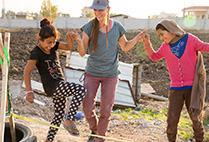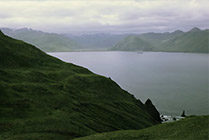
Here’s an unusual way to escape the pressures of studying for a PhD in molecular biology: try walking across a 170-foot flat rope strung between two rock cliffs hundreds of feet above the ground. That was the recreation of choice for Sonya Iverson.
Highlining, says Iverson (GRS’16), involves walking a flat rope, actually a strand of webbing, that is high enough off the ground that the walker has to tie in to it for safety, a height that in her mind starts at 30 feet and goes to—well, she has a friend who walked a rope strung between hot-air balloons. Generally, she says, highliners commonly choose more terrestrial mounts, such as trees, cliffs, and buildings.

Slacklining with Syrian refugees in the Bekaa Valley in Beirut, Lebanon.
Iverson had been fascinated by the Middle East since taking a history of religions course as an undergraduate at Montana State University, and when she saw pictures of highliners in Iran in 2012, she got in touch with them via Facebook. The Iranian highliners offered to smooth the visa process, and the only thing Iverson needed was someone to go with her.
“I got lucky,” she says. “One of my friends said she would go.”
That friend was Jade Tabony (SPH’14), who was working on a master’s degree in environmental health. “I said, ‘Jade, you don’t highline.’ She said, ‘I’ll learn.’”
And she did.
Since then, Iverson has highlined in several countries, including Turkey, Norway, and China. She and Tabony also founded the nonprofit Crossing Lines, which uses slacklining, a cousin to highlining that uses a loosely strung rope that is often just a couple of feet off the ground, to help refugees gain confidence and build relationships. Slacklining, says Iverson, has been shown to help people concentrate, which in turn improves learning potential.
Iverson has worked with refugees in Lebanon, and the Crossing Lines crew is now organizing slacklining classes both for refugees and for others to teach refugees in Denver, Los Angeles, and Phoenix.

Building coordination and confidence.
“Slacklining connects people,” says Iverson, who has worked as a consultant for several biotech companies, conducting feasibility studies and creating marketing materials. “It brings together people who have little in common. With refugees, it teaches coordination and fine motor skills. It also builds confidence.”











































Related Stories
Picturing a Long-Gone Citadel
Was a Bronze Age city in Turkey abandoned because of climate change or fire?
Terriers Share Their Most Embarrassing Freshman Moments
Awkward situations they may want to forget
An Unconventional OB/GYN
New MED grad brings back lessons in global health from Lebanon
Post Your Comment